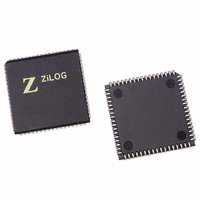Z16C3510VSG Zilog, Z16C3510VSG Datasheet - Page 176

Z16C3510VSG
Manufacturer Part Number
Z16C3510VSG
Description
IC 10MHZ Z8500 CMOS ISCC 68-PLCC
Manufacturer
Zilog
Series
IUSC™r
Specifications of Z16C3510VSG
Controller Type
Serial Communications Controller (SCC)
Interface
USB
Voltage - Supply
4.75 V ~ 5.25 V
Current - Supply
50mA
Operating Temperature
0°C ~ 70°C
Mounting Type
Surface Mount
Package / Case
68-LCC (J-Lead)
Lead Free Status / RoHS Status
Lead free / RoHS Compliant
Available stocks
Company
Part Number
Manufacturer
Quantity
Price
- Current page: 176 of 268
- Download datasheet (3Mb)
Application Note
SCC in Binary Synchronous Communications
SYNCHRONOUS MODES
Three variations of character-oriented synchronous
communications are supported by the Z-SCC: Mono-sync,
Bisync, and External Sync (Figure 1). In Monosync mode,
a single sync character is transmitted, which is then
compared to an identical sync character in the receiver.
When the receiver recognizes this sync character,
synchronization is complete; the receiver then transfers
subsequent characters into the receiver FIFO in the Z-
SCC.
SYSTEM INTERFACE
The Z8002 Development Module consists of a Z8002 CPU,
16K words of dynamic RAM, 2K words of EPROM monitor,
a Z80A SIO providing dual serial ports, a Z80A CTC
peripheral device providing four counter/timer channels, two
Z80A PIO devices providing 32 programmable I/O lines,
and wire wrap area for prototyping. The block diagram is
depicted in Figure 2. Each of the peripherals in the
development module is connected in a prioritized daisy-
chain configuration. The Z-SCC is included in this
configuration by tying its IEI line to the IEO line of another
device, thus making it one stop lower in interrupt priority
compared to the other device.
10-2
Figure 1. Synchronous Modes of Communication
SYNC
SYNC
SYNC
SYNC Symbol
External
A. MONOSYNC Mode
B. BISYNC Mode
C. External SYNC Mode
DATA
DATA
DATA
DATA
DATA
DATA
CRC1
CRC1
CRC1
CRC2
CRC2
CRC2
Bisync mode uses a 16-bit or 12-bit sync character in the
same way to obtain synchronization. External Sync mode
uses an external signal to mark the beginning of the data
field; i.e., an external input pin (SYNC) indicates the start
of the information field.
In all synchronous modes, two Cyclic Redundancy Check
(CRC) bytes can be concatenated to the message to
detect data transmission errors. The CRC bytes inserted in
the transmitted message are compared to the CRC bytes
computed to the receiver. Any differences found are held
in the receive error FIFO.
Two Z8000 Development Modules containing Z-SCCs are
connected as shown in Figure 3 and Figure 4. The
Transmit Data pin of one is connected to the Receive Data
pin of the other and vice versa. The Z8002 is used as a
host CPU for loading the modules’ memories with software
routines.
The Z8000 CPU can address either of the two bytes
contained in 16-bit words. The CPU uses an even address
(16 bits) to access the most-significant byte of a word and
an odd address for the least-significant byte of a word.
UM011001-0601
Related parts for Z16C3510VSG
Image
Part Number
Description
Manufacturer
Datasheet
Request
R

Part Number:
Description:
CMOS ISCC INTEGRATED SERIAL COMMUNICATIONS CONTROLLER
Manufacturer:
ZILOG [Zilog, Inc.]
Datasheet:

Part Number:
Description:
Communication Controllers, ZILOG INTELLIGENT PERIPHERAL CONTROLLER (ZIP)
Manufacturer:
Zilog, Inc.
Datasheet:

Part Number:
Description:
KIT DEV FOR Z8 ENCORE 16K TO 64K
Manufacturer:
Zilog
Datasheet:

Part Number:
Description:
KIT DEV Z8 ENCORE XP 28-PIN
Manufacturer:
Zilog
Datasheet:

Part Number:
Description:
DEV KIT FOR Z8 ENCORE 8K/4K
Manufacturer:
Zilog
Datasheet:

Part Number:
Description:
KIT DEV Z8 ENCORE XP 28-PIN
Manufacturer:
Zilog
Datasheet:

Part Number:
Description:
DEV KIT FOR Z8 ENCORE 4K TO 8K
Manufacturer:
Zilog
Datasheet:

Part Number:
Description:
CMOS Z8 microcontroller. ROM 16 Kbytes, RAM 256 bytes, speed 16 MHz, 32 lines I/O, 3.0V to 5.5V
Manufacturer:
Zilog, Inc.
Datasheet:

Part Number:
Description:
Low-cost microcontroller. 512 bytes ROM, 61 bytes RAM, 8 MHz
Manufacturer:
Zilog, Inc.
Datasheet:

Part Number:
Description:
Z8 4K OTP Microcontroller
Manufacturer:
Zilog, Inc.
Datasheet:

Part Number:
Description:
CMOS SUPER8 ROMLESS MCU
Manufacturer:
Zilog, Inc.
Datasheet:

Part Number:
Description:
SL1866 CMOSZ8 OTP Microcontroller
Manufacturer:
Zilog, Inc.
Datasheet:

Part Number:
Description:
SL1866 CMOSZ8 OTP Microcontroller
Manufacturer:
Zilog, Inc.
Datasheet:

Part Number:
Description:
OTP (KB) = 1, RAM = 125, Speed = 12, I/O = 14, 8-bit Timers = 2, Comm Interfaces Other Features = Por, LV Protect, Voltage = 4.5-5.5V
Manufacturer:
Zilog, Inc.
Datasheet:











